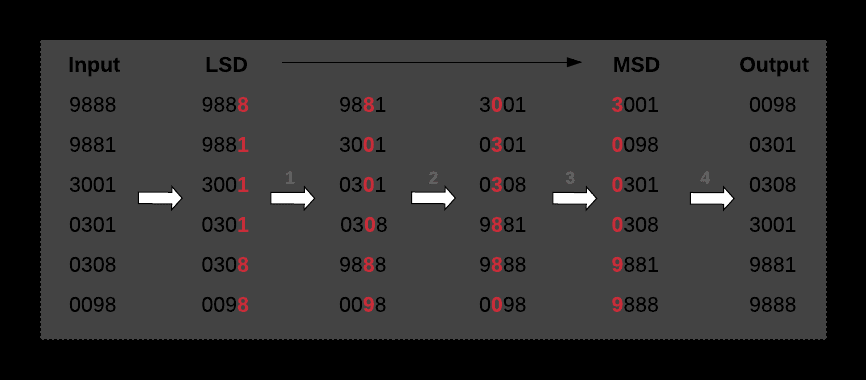algos stuff. summary sheet. Information here is all a combination from LeetCode & GeeksforGeeks
Summary: Big O Cheat Sheet
Searching
- Linear Search
- Binary Search
- Jump Search
Linear Search
iterate through entire array, to search for intended item
Time Complexity: O(N)
Binary Search
searching for specific value in an ordered collection
- Target - value to search for
- Index - current location
- Left, Right - indices from to maintain search space
- Mid - index to apply condition to decide if search left or right
How it works
- Get middle index of sequence, apply search condition to middle index
- if unsatisfied / values unequal, half of sequence is eliminated
- Continue search in remaining half until target is found
Complexity
Recursion
Time Complexity: O(log(n))
Space Complexity: O(log(n)) (height of stack call, ~ height of binary tree)
Iterative
Time Complexity: O(log(n))
Space Complexity: O(1)
public int search(int[] nums, int target) {
int left = 0;
int right = nums.length -1;
int midIdx = ((right - left) / 2 ) + left;
while (left <= right) {
if (nums[midIdx] < target) {
// search in right half
left = midIdx +1;
midIdx = ((right-left) / 2) + left;
} else if (nums[midIdx] > target) {
// search in left half
right = midIdx - 1;
midIdx = ((right - left) / 2) + left;
} else {
// nums[midIdx] == target
return midIdx;
}
}
return -1;
}
Jump Search
Check fewer items then linear search ( in sorted array) by jumping / skipping elements.
- Search elements in array by index 0,m,2m etc.
- find indexes where arr[k*m] < target < arr[(*k+1)m]
- linear search from k*m till (*k+1)m to find target
optimal block size to skip
Time complexity = (N/m) + m
For minimum time complexity,
1 = (N/m) + m
1 - m = N / m
m - m2 = N
m ~ sqrt(N)
Therefore, optional block size (m) is sqrt(N)
Complexity
Space Complexity: O(1)
Time Complexity:
assuming optimum block size m = sqrt(N),
Time Complexity = (N/m) + m
= (N/sqrt(N)) + sqrt(N)
= sqrt(N) + sqrt(N)
~ O(sqrt(N))
Sorting
Impt: understand trade offs for each algorithm
Elementary : n2
- Bubble Sort (stable)
- Insertion Sort (stable)
- Selection Sort (stable)
More complex : n*log(n), divide and conquer
- Merge Sort (stable)
- Quick Sort (unstable)
depending on the type of input (eg. list is reversed / nearly sorted) algo will perform differently
For options 4 & 5. merge and quick sort utilize Divide and conquer. Divide and conquer gives log(n) advantage.
sort()
Java arrays.sort() uses dual pivot quick sort
complexity: O(n log(n))
Stable VS Unstable sort
Stable: objects with equal keys appear in the same order in sorted output as input.
** if two objects are compared as equal their order is preserved**
Taken from SO answer
When is stable sort required?
Stable sort is needed when equal elements are distinguishable.
e.g. multiple criterias for sort. sort by object.A THEN object.B
in stable sort. sort by object.B THEN object.A.
Eg. Radix sort.
sorting integers by digits that share the same significant position & value

1. Bubble Sort
repeatedly swap adjacent elements if they are in the wrong order
First pass brings max value to the end of array. second pass brings 2nd max value to second last index of array. To sort all indexes in ascending order need to do N passes. therefore complexity of n2
Time Complexity: O(n2)
Space Complexity: O(1)
Stable: yes
Input: 4A 5 3 2 4B 1
1st pass: 4A 3 2 4B 1 5
2nd pass:
3 4A 2 4B 1 5
3 2 4A 4B 1 5
3 2 4A 4B 1 5
3 2 4A 1 4B 5
3rd pass:
3 2 1 4A 4B 5
output: 1 2 3 4A 4B 5
2. Selection Sort
Find minimum element from unsorted part and putting it at the beginning. min element and element at beginning swap places.
First pass through unsorted part to get min value. Second pass through unsorted part to get second min value. N passes are needed to sort all elements in the unsorted part.
Time Complexity: O(n2)
Space Complexity: O(1)
Stable: no
Input : 4A 5 3 2 4B 1
Output :
1st: 1 5 3 2 4B 4A
2nd: 1 2 5 3 4B 4A
final: 1 2 3 4B 4A 5
swapping of places 4A and 1 made the selection sort unstable
Code example
void sort(int arr[])
{
int n = arr.length;
// One by one move boundary of unsorted subarray
for (int i = 0; i < n-1; i++)
{
// Find the minimum element in unsorted array
int min_idx = i;
for (int j = i+1; j < n; j++)
if (arr[j] < arr[min_idx])
min_idx = j;
// Swap the found minimum element with the first
// element
int temp = arr[min_idx];
arr[min_idx] = arr[i];
arr[i] = temp;
}
}
3. insertion Sort
best for: small dataset & nearly sorted data
array is virtually split into a sorted and an unsorted part. Values from the unsorted part are picked and placed at the correct position in sorted part. (compare one by one with elements in sorted part to find correct position).
class Solution {
static void insert(int arr[],int i) {
int num = arr[i];
int insertionIdx = i;
for (int j=i-1;j>=0;j--) {
if (arr[i] < arr[j]) {
insertionIdx--;
if (j==0) {
break;
}
}else {
break;
}
}
for (int x=i;x>insertionIdx;x--) {
arr[x]=arr[x-1];
}
arr[insertionIdx] = num;
}
//Function to sort the array using insertion sort algorithm.
public void insertionSort(int arr[], int n) {
//code here
for (int i=1;i<arr.length;i++) {
if (arr[i] < arr[i-1]) {
int index = i-1;
insert(arr,i);
}
}
}
}
Time Complexity
Best Case : O(n)
In best case, array already sorted, one pass, check that first element in unsorted part, is larger than last element in sorted part.
Worst & Average Case : O(n2
In worse case, array sorted in reverse order. algorithm will scan and shift through entire sorted subsection before inserting. will do this N times for all elements. so n2
Stable: Yes
Input: 4A 5 3 2 4B 1
Output:
1st pass: 1 4A 5 3 2 4B
2nd pass: 1 2 4A 5 3 4B
3rd pass: 1 2 3 4A 5 4B
4th pass: 1 2 3 4A 5 4B
output: 1 2 3 4A 4B 5
4. Merge Sort
Divide and Conquer algorithm
Divides the input array into two halves, (until each subarray is only size 2) calls itself for the two halves, and then merges the two sorted halves.
array is recursively divided into 2 halves until size is 1. Once size is 1, merge process starts and arrays are merged till complete array is merged.
Time Complexity: O(n*log(n))
Space Complexity: O(n)
Stable: yes
5. Quick Sort
best for: average complexity. Avoid if you cant garuntee a good pivot
Divide and conquer. Pick element as pivot point. Split array into two halves, lower than pivot element and higher than pivot element. Repeat process on subarrays until the halves have lenght of 1. Then combine all the elements back together to 1 array.
Time Complexity:
Best / Average : O (n*log(n))
Worst : O(n2)
worst case if the pivot point is the largest/ smallest element. List is not split into half.
Space Complexity: O(log(n))
Stable: no
Non-comparison Sort
Sorts are hard to beat O(n*log(n)) because you have to compare each element. to beat log(n) you need non-comparison sort
takes advantage of the way numbers (specifically integers) are stored in memory.
only work with numbers in a specific range
- Radix sort
- Counting sort
could be faster than merge or quick sort
When to use which sorting algo?
Insertion
few items / items are mostly sorted.
Bubble
Selection
Merge Sort
- best average and worst case is always O(n*log(n)) --> we will always divide up the list equally.
- if data set is big, suitable if you have external sorting (space complexity of O(n)) (data does not fit into main memory of computer device) Quick Sort
- avoid if you are scared of worst case (cannot garuntee good pivot)
- suitable if there is no external sorting. space complexity of O(log(n)) Radix / Counting Sort
- sorting integers
Trees & Graph - Searching
BFS VS DFS
BFS:
node is in upper level of tree
- shortest path / closest nodes
- more memory (need to keep tarck of current nodes)
DFS:
node is in lower level of tree
- less memory / does path exist?
- can get slow
Eg.
- solution if not far from root of tree BFS
tree is deep, solutions are rare
BFS (DFS will take long time) ORtree is very wide
DFS (BFS will need too much memory)solutions are frequent but located deep in tree
DFSpath exist between 2 nodes
DFSpath exist between two nodes
BFS
Djisktra & Bellman-Ford
shortest path between two nodes of weighted graph
- Bellman: can accommodate for negative weights
- Djisktra: more efficient but cannot accommodate for negative weights (greedy algo)
Djisktra cannot accomodate negative weights because it assumes "adding" a weight can never make a path shorter.














Top comments (0)